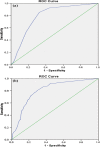The Brief Obsessive-Compulsive Scale (BOCS): a self-report scale for OCD and obsessive-compulsive related disorders
- PMID: 24568661
- PMCID: PMC4221004
- DOI: 10.3109/08039488.2014.884631
The Brief Obsessive-Compulsive Scale (BOCS): a self-report scale for OCD and obsessive-compulsive related disorders
Abstract
Background: The Brief Obsessive Compulsive Scale (BOCS), derived from the Yale-Brown Obsessive-Compulsive Scale (Y-BOCS) and the children's version (CY-BOCS), is a short self-report tool used to aid in the assessment of obsessive-compulsive symptoms and diagnosis of obsessive-compulsive disorder (OCD). It is widely used throughout child, adolescent and adult psychiatry settings in Sweden but has not been validated up to date.
Aim: The aim of the current study was to examine the psychometric properties of the BOCS amongst a psychiatric outpatient population.
Method: The BOCS consists of a 15-item Symptom Checklist including three items (hoarding, dysmorphophobia and self-harm) related to the DSM-5 category "Obsessive-compulsive related disorders", accompanied by a single six-item Severity Scale for obsessions and compulsions combined. It encompasses the revisions made in the Y-BOCS-II severity scale by including obsessive-compulsive free intervals, extent of avoidance and excluding the resistance item. 402 adult psychiatric outpatients with OCD, attention-deficit/hyperactivity disorder, autism spectrum disorder and other psychiatric disorders completed the BOCS.
Results: Principal component factor analysis produced five subscales titled "Symmetry", "Forbidden thoughts", "Contamination", "Magical thoughts" and "Dysmorphic thoughts". The OCD group scored higher than the other diagnostic groups in all subscales (P < 0.001). Sensitivities, specificities and internal consistency for both the Symptom Checklist and the Severity Scale emerged high (Symptom Checklist: sensitivity = 85%, specificities = 62-70% Cronbach's α = 0.81; Severity Scale: sensitivity = 72%, specificities = 75-84%, Cronbach's α = 0.94).
Conclusions: The BOCS has the ability to discriminate OCD from other non-OCD related psychiatric disorders. The current study provides strong support for the utility of the BOCS in the assessment of obsessive-compulsive symptoms in clinical psychiatry.
Keywords: Assessment; Attention deficit hyperactivity disorder; Autism; Compulsive behaviour; Obsessions.
Figures


References
-
- Okasha A, Lotaief F, Ashour AM, el Mahalawy N, Seif el Dawla A, el-Kholy G. The prevalence of obsessive compulsive symptoms in a sample of Egyptian psychiatric patients. Encephale. 2000;26:1–10. - PubMed
-
- Wahl K, Kordon A, Kuelz KA, Voderholzer U, Hohagen F, Zurowski B. Obsessive–compulsive disorder (OCD) is still an unrecognised disorder: A study on the recognition of OCD in psychiatric outpatients. Eur Psychiatry. 2010;25:374–7. - PubMed
-
- Goodman WK, Price LH, Rasmussen SA, Mazure C, Fleischmann RL, Hill CL, et al. The Yale–Brown Obsessive Compulsive Scale. I. Development, use, and reliability. Arch Gen Psychiatry. 1989;46:1006–11. - PubMed
-
- Goodman WK, Price LH, Rasmussen SA, Mazure C, Delgado P, Heninger GR, et al. The Yale–Brown Obsessive Compulsive Scale. II. Validity. Arch Gen Psychiatry. 1989;46:1012–6. - PubMed
Publication types
MeSH terms
LinkOut - more resources
Full Text Sources
Other Literature Sources
Medical
